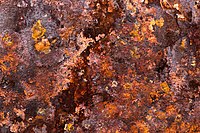
Photo from wikipedia
Abstract Ferrous iron (Fe(II)) is ubiquitous in soils and sediments, where it often participates in biogeochemical reactions that determine the environmental behavior of numerous pollutants owing to its reductive activity.… Click to show full abstract
Abstract Ferrous iron (Fe(II)) is ubiquitous in soils and sediments, where it often participates in biogeochemical reactions that determine the environmental behavior of numerous pollutants owing to its reductive activity. Minerals can further promote the reductive activity of Fe(II) via specific adsorption. In this work, titanium-pillared montmorillonite composites (TPMt) were designed, prepared, and calcined at various temperatures to investigate their catalytic performance in promoting the reductive activity of Fe(II) at solid/water interfaces under anoxic conditions. The TPMt were comprehensively characterized using various techniques, including X-ray diffraction, scanning and transmission electron microscopy, N2 adsorption– desorption isotherms, pyridine Fourier-transform infrared spectroscopy, NH3 temperature-programmed desorption and electrochemical impedance spectroscopy, and 2-nitrophenol was used to probe the reductive catalytic activity (RCA) of the TPMt. The results revealed that the RCA performances of the TPMt first increased and then decreased as the calcination temperature was increased from 100 to 500 °C. In particular, the sample annealed at 200 °C displayed the optimal RCA for Fe(II), completely reducing 2-nitrophenol within 10 min at pH 7.0. In addition to the pH and Fe(II) concentration, the catalyst structure, anatase TiO2 content and distribution, surface acidity, and impedance were found to be major factors governing the reductive transformation of 2-nitrophenol by the Fe(II) species adsorbed onto the TPMt. A plausible mechanism that accounts for the improved RCA performance is also proposed and discussed.
Journal Title: Applied Clay Science
Year Published: 2021
Link to full text (if available)
Share on Social Media: Sign Up to like & get
recommendations!